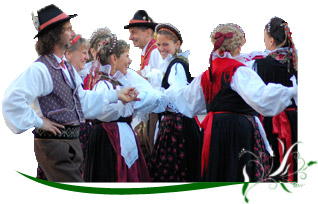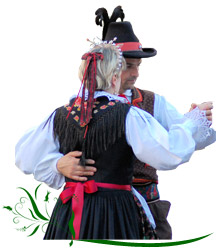 It had been founded in 1928 for the first time. It did several performances both in the vallev of Primiero and in the nrovince of Trento (Predazzo, Cavalese, Levico, Trento). It had a stasis during the period of‘ Ethiopian war and the last world war; afterwords it resumed and took part in several feasts. Its members were dressed with the typical costumes.
It had been founded in 1928 for the first time. It did several performances both in the vallev of Primiero and in the nrovince of Trento (Predazzo, Cavalese, Levico, Trento). It had a stasis during the period of‘ Ethiopian war and the last world war; afterwords it resumed and took part in several feasts. Its members were dressed with the typical costumes.
It has been refounded in 1957-1958 officially, having done different performances. Its members begun to dress the typical and original costumes of the valley of Primiero again. Since then it had an intense activity of performances and not only in Primiero, but also in the whole Trentino, Veneto and in other Italian regions (Lombardia, Liguria, Toscana, Puglia, Campania, etc.) and abroad too (France, Germany, Holland, Switzerland, Belgium and Egypt).
DANCES
The Group is going to have about ten dances, whictn show 'the particular characteristics of the valley. Most of all it performes old music compositions, whose authors are unknown. These compositions have been handed on from one generation to another one.
THE PROGRAM:
First Part:
 Entrance and greetings dance: only two couples of dancer dance while the other members are at side and in the centre of the platform. (Polka).
Entrance and greetings dance: only two couples of dancer dance while the other members are at side and in the centre of the platform. (Polka).- The waltz of the woman, who is spinning (Il Walzer- della donna che fila) - it is a typical local dance and it reminds the old entertainment at home during the winter period, when the women spinned the flax and the hemp, which were grown in valley of Primiero. Regard to this there is also a feast called "il dobia dele filaresse", that is celebrated on the last Thursday of January. The dance is spectacular. The dancers dance around a woman, who is spinning really.
- Dance called "standtshizzera" or "bersagliera": it is a quick and funny polka, which is danced like the old way.
- Simple Pairis (Pairis semplice) - it is a local and characteristic dance, that is fairly well choreographic.
- Mazurka della "gramola" e della "spigola": it is a dance of old origin, that is danced by several couples of dancers.
- "La stiriana": it is an imported dance, that has been built of local features.
- Choreographic exit.
 Tunnel (Il Tunnel) - it is a polka, which recalls the miners and the so called "AISEMPONERI". Aisemponeri were the workmen, who worked in the railway constructions in Switzerland, in Austria and in Germany.
Tunnel (Il Tunnel) - it is a polka, which recalls the miners and the so called "AISEMPONERI". Aisemponeri were the workmen, who worked in the railway constructions in Switzerland, in Austria and in Germany.- Pairis with seven steps (Pairis dei sette passi) - it is a lively dance with several changes.
- "Il walzer delle ghede" (apron): it is accompanied by a song; it is very choreographic and varied.
- Maria "maridete" (marry you): it is a polka accompanied by a song. It is very humorous and funny.
- Varied Pairis (Pairis variata): it is another local and characteristic dance with several changes, unexpected interruptions, etc.
- Mazurka of the lovers (Mazurka degli innamorati): it is an old dance with lot and varied choreography.
- The final exit with greetings.
Second Part:
Furthermore the group could do other several dances and the musical band could play every kind of musical pieces in order to entertain everybody for the all night. The band could play both the old musical pieces and the modern ones. It usually uses the accordian, the guitar, the double-bass, and sometimes the drums, too.
The group is composed by:
- a presenter
- 4 musicians (2 accordians, 1 guitar, 1 double-bass)
- 6-8 couples of dancers.

